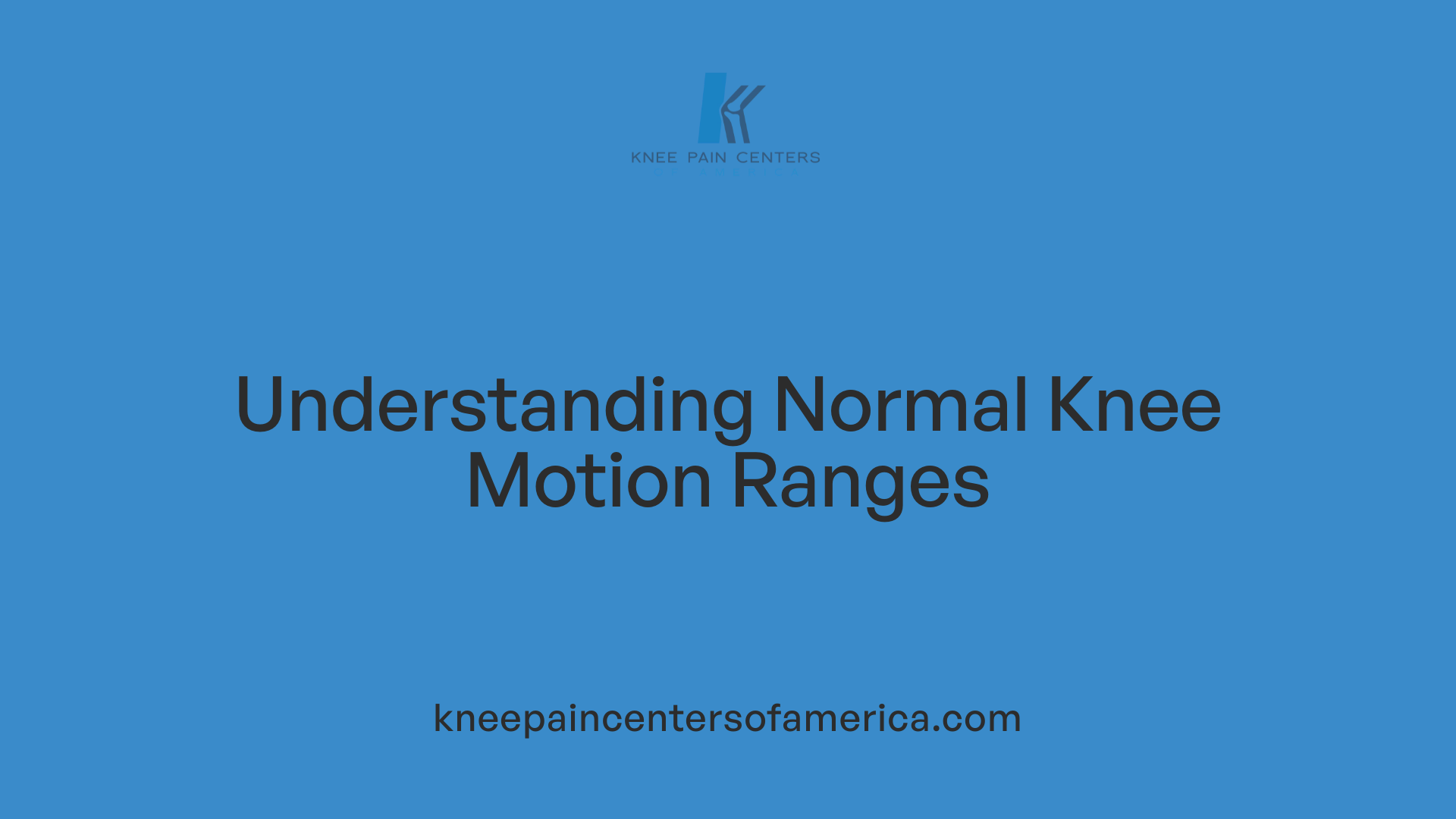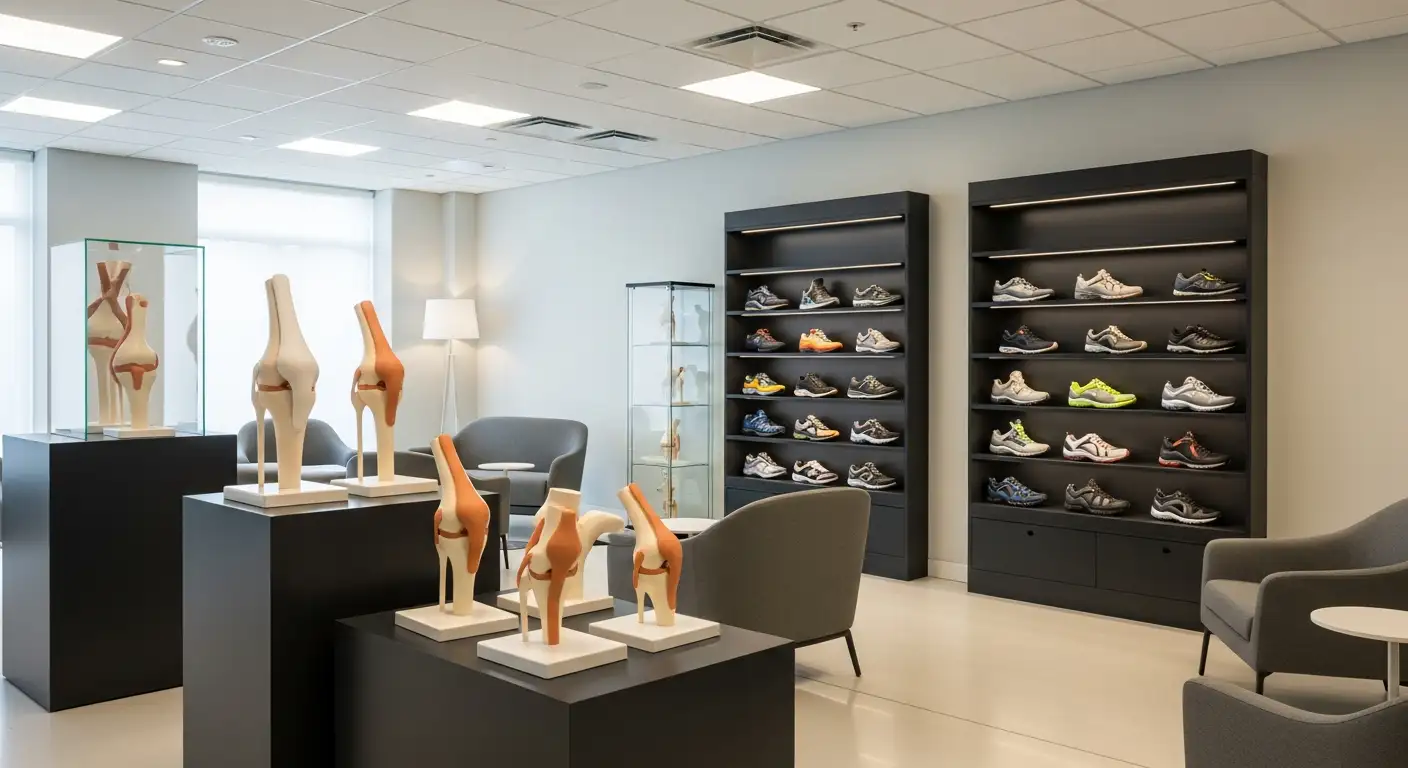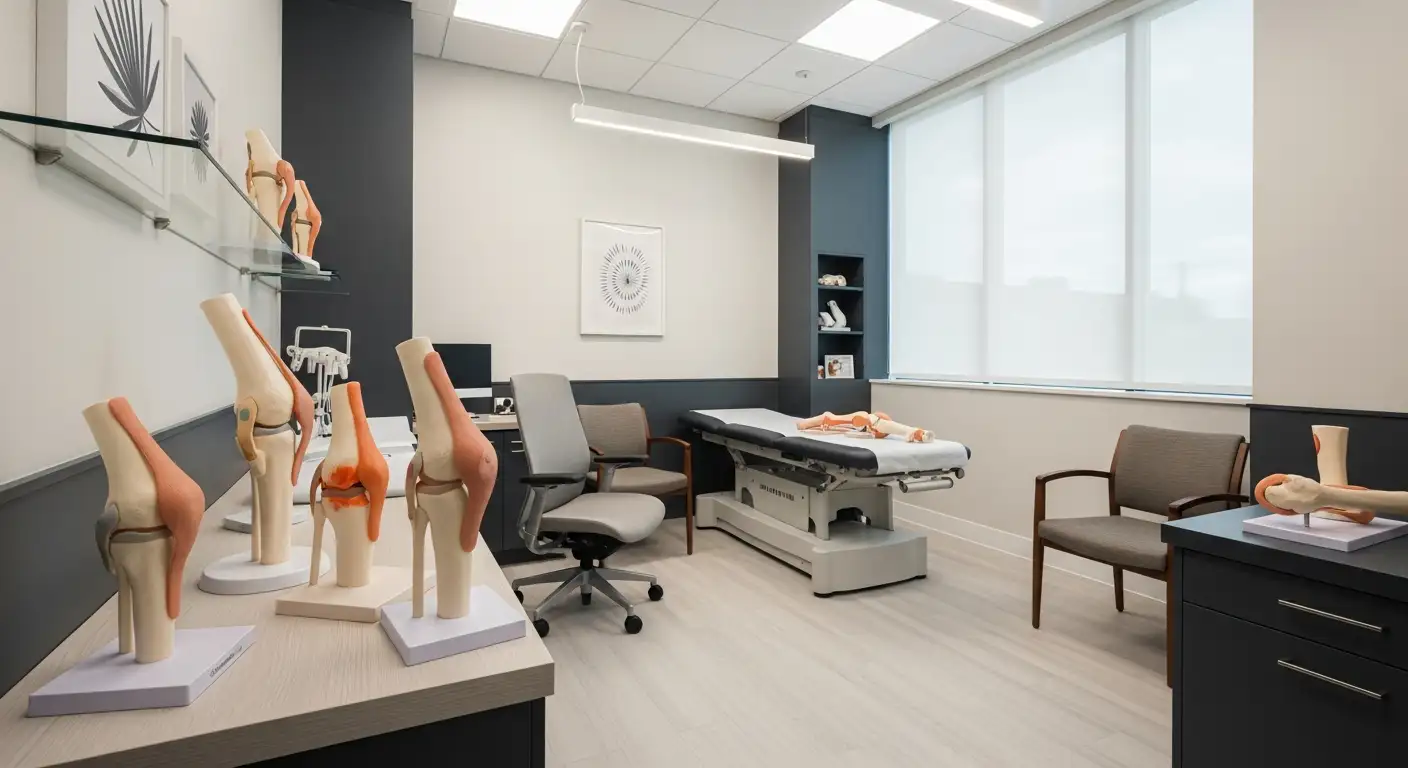An Introduction to Normal Knee Range of Motion
Knee mobility plays a critical role in enabling daily activities, from walking to kneeling. Understanding what constitutes normal knee range of motion (ROM) is vital for assessing joint health, diagnosing impairments, and guiding rehabilitation after injury or surgery. This article explores the accepted standards of knee mobility, methods of measurement, factors influencing ROM, and benchmarks for recovery, offering comprehensive insights rooted in scientific data and clinical practice.
Standard Ranges of Knee Motion in Healthy Adults

What is considered the normal range of motion for the knee?
The typical knee joint allows for both bending and straightening, fundamental to everyday activities like walking, sitting, and climbing stairs.
Normal knee flexion—the movement that bends the knee—is generally between 135 and 155 degrees. This range enables a person to perform many functional activities comfortably, such as sitting cross-legged or climbing stairs.
Knee extension, the ability to straighten the leg, is normally close to 0 degrees, with slight hyperextension up to about 15 degrees in some individuals. Full extension is crucial for stability and efficient gait.
In clinical practice, active and passive measurements are used to assess these movements. Active ROM involves muscle movement, while passive ROM is measured when an examiner moves the joint.
How much variation exists among individuals?
There is some variability in the knee's normal range of motion among healthy adults. Factors influencing this include age, sex, and athletic activity levels.
Younger individuals tend to have higher ranges, with some older adults experiencing a slight reduction—typically a 3 to 5 degree decrease with age.
Women often demonstrate greater flexibility than men, notably in extension and flexion. Additionally, certain conditions such as arthritis, previous injuries, or surgeries can alter the typical ranges.
For example, the study measuring active knee flexion in elderly populations showed averages around 138 degrees, slightly below the textbook ideal but still within a functional range.
Why is understanding these ranges clinically important?
Knowing the normal ranges helps healthcare professionals identify abnormal joint mobility, which can indicate injury, arthritis, or other pathologies.
Limited extension can cause gait problems and knee pain, while restricted flexion may impair activities like sitting or climbing stairs.
Rehabilitation programs after surgery or injury aim to restore the knee's motion close to normal, usually targeting at least 110 to 130 degrees of flexion and full or near-full extension.
Monitoring progress through goniometry or other measurement techniques informs treatment effectiveness and guides activity modifications.
| Movement | Typical Range in Adults | Activity Examples | Notes |
|---|---|---|---|
| Knee Flexion | 130-150 degrees | Sitting, climbing stairs, squatting | Variations depend on age, sex, and health status |
| Knee Extension | 0-15 degrees (hyperextension possible) | Standing straight, gait, kicking a ball | Complete extension essential for gait stability |
Understanding these ranges ensures timely intervention when deviations are observed, helping maintain mobility and quality of life.
For further information, search
Measurement Techniques and Normative Values

What are the typical measurement values for knee range of motion?
The standard range of motion (ROM) for the knee joint typically spans from full extension at 0 degrees to around 140-150 degrees of flexion. This range allows for essential daily activities, with 60 degrees of flexion sufficient for walking and 90 degrees needed for comfortable sitting.
During clinical assessments, a goniometer is commonly used to measure knee mobility. The patient usually lies supine, and the therapist positions the goniometer with its axis at the lateral epicondyle of the femur. The stationary arm aligns along the femur towards the greater trochanter, while the moving arm follows the fibula toward the lateral malleolus.
Variations exist depending on demographic factors. For example, females tend to have slightly more flexibility, and aging can lead to a gradual decrease—about 3 to 5 degrees—in joint mobility.
In most adults, normal knee extension can slightly hyperextend up to -5 degrees, which can contribute to walking efficiency. Precise measurement helps identify impairments and guide rehabilitation, especially after injury or surgery.
Clinical assessment protocols
Standard assessment protocols involve measuring active and passive range of motion. Active ROM refers to the movement achieved by the patient, while passive ROM involves clinician-assisted movement, providing information about tissue extensibility and joint health.
Postoperative evaluations, particularly after knee surgeries like ACL reconstruction or total knee replacement, aim to restore ROM to near-normal levels. Exercises like heel slides, stationary cycling, and stretching are incorporated into therapy programs.
Monitoring changes in ROM over time is essential for evaluating recovery. Clinicians also evaluate end-feel—soft tissue, tissue stretch, or other sensations at joint limits—to diagnose potential issues like scar tissue formation.
Variations across demographics
Age, sex, and overall health influence normal knee ROM. Younger individuals generally have greater flexibility, while older adults may experience reductions—often around 3 to 5 degrees—due to joint degeneration or decreased tissue elasticity.
Women tend to exhibit slightly higher ROM than men, especially in joints like the knee. These differences are relevant when setting rehabilitation goals and assessing normalcy.
Summary table of normal knee ROM values:
| Parameter | Typical Range | Notes |
|---|---|---|
| Flexion | 135-150° | Essential for activities like sitting or climbing stairs |
| Extension | 0° (full extension), hyperextension up to -5° | Full extension necessary for standing and walking |
| Hyperextension | Up to -5° | Slight hyperextension common in healthy individuals |
| Functional flexion | About 60° | Sufficient for walking |
| Post-surgical goal | ≥ 115° | For optimal function after knee procedures |
Understanding and accurately measuring knee ROM are crucial for diagnosing impairments, planning treatment, and evaluating recovery progress.
Factors Influencing Knee Range of Motion
 Understanding what affects knee range of motion (ROM) is crucial for effective rehabilitation and surgical outcomes. Several factors play significant roles in determining how well an individual can regain or maintain knee mobility.
Understanding what affects knee range of motion (ROM) is crucial for effective rehabilitation and surgical outcomes. Several factors play significant roles in determining how well an individual can regain or maintain knee mobility.
One important aspect is preoperative knee function. Patients with higher preoperative flexion angles and better tibiofemoral alignment tend to experience improved ROM after surgery. This means that the condition of the knee before intervention can predict how much mobility can be restored.
Timing of surgical intervention also influences ROM outcomes. Early surgery, while the knee still maintains good function, is often associated with better postoperative mobility. Delayed procedures may lead to increased stiffness and reduced flexibility.
Postoperative management is another critical factor. Achieving optimal ROM at the one-year mark, managing pain effectively, and adhering to rehabilitation protocols can significantly impact long-term mobility. For instance, patients who maintain adequate flexion after surgery and have minimal pain generally experience better functional outcomes.
Additional variables include body mass index (BMI), which affects load and stress on the joint, and previous surgeries that might alter tissue integrity. The condition of soft tissues around the knee, including muscles, ligaments, and joint capsules, also influences recovery. Tight or damaged soft tissues can hinder movement and require targeted therapy.
In summary, the main contributors to successful knee mobility recovery involve the initial condition of the knee, timely surgical intervention, effective postoperative management, and healthy soft tissue status. Addressing these factors holistically can enhance rehabilitation efforts and improve patient mobility.
For more detailed insights, searching the term "Factors affecting knee mobility recovery" can provide additional evidence-based information.
Postoperative Expectations and Rehabilitation Benchmarks

What is the expected postoperative knee range of motion after knee surgery or replacement?
Following knee surgery or a total knee replacement, patients can typically expect notable improvements in joint mobility during the first few months of recovery. The average final flexion measurement tends to be around 132 degrees, with a variability of about 8 degrees. This means most patients achieve flexion ranging from approximately 96 to 140 degrees.
Achieving a knee extension of 0 degrees—meaning the leg is fully straight—is a common and important goal. Together with flexion of at least 120 degrees, these ranges allow individuals to perform most daily activities comfortably, such as walking, sitting, and climbing stairs.
The trajectory of improvement varies depending on preoperative mobility, underlying conditions, and individual health factors. Typically, flexion improves rapidly within the first 3 months post-surgery, while extension may continue to improve up to 6 months.
Many patients ultimately reach flexion levels close to the normal range, usually around 125 degrees. However, some may attain slightly less, particularly if preoperative ROM was limited or if other factors like body mass index (BMI) influenced recovery.
Preoperative joint mobility and the presence of conditions such as osteoarthritis can significantly influence outcomes. Patients with better baseline mobility and osteoarthritis generally experience more favorable results.
Rehabilitation programs emphasizing physiotherapy and targeted exercises are essential. Continued effort to regain and improve ROM can lead to optimal functional performance.
Recovery timelines are individual, but consistent rehabilitation generally yields significant gains in range of motion, enabling patients to return to daily activities with minimal difficulty.
Assessment Methods for Knee Flexibility

How is knee flexibility assessed?
Knee flexibility is mainly evaluated through measurements of the joint's range of motion (ROM). Healthcare professionals often use a device called a goniometer to quantify the degrees of knee flexion and extension during physical examinations. This simple but effective tool helps determine how well the knee moves within its normal limits.
One of the most common tests is the Active Knee Extension Test. During this test, the patient lies on their back with hips and knees flexed at 90 degrees. The patient then actively extends the knee as much as possible. This assessment evaluates hamstring muscle length and active knee extension capacity.
To improve the reliability of these measurements, the knee should be stabilized properly to prevent compensatory movements. The assessments can be done by physical therapists, physicians, or even by individuals using proper techniques at home.
In addition to goniometric measurements, clinicians often observe the movement pattern during activities like walking, sitting, or climbing stairs. Simple visual assessments can detect limitations, asymmetries, or abnormal movement patterns that suggest decreased flexibility.
Another useful test is the straight leg raise, which helps further isolate hamstring muscle tightness. This involves lifting the leg passively while keeping the knee straight, measuring the angle at which tension or discomfort occurs.
Combining precise objective measurements with observation provides a comprehensive understanding of knee flexibility. Such assessments are crucial for diagnosing issues, planning rehabilitation, and tracking recovery progress.
Distinguishing Normal from Abnormal Movement
How can one differentiate between normal and abnormal knee movement?
Assessing knee movement involves examining both how the joint functions during activity and its structural integrity. Normal knee movement typically appears smooth and pain-free, with active flexion reaching about 135 degrees and extension close to 0 degrees. The joint should demonstrate symmetrical motion on both sides, with no swelling, firmness, or instability.
In contrast, abnormal movement might include limited knee flexion or extension, pain during activity, swelling, or noticeable joint instability. Patients with such issues may display altered gait patterns, like limping or crouching, which suggest mechanical problems or soft tissue damage.
To further evaluate, clinicians often utilize imaging tests such as X-rays or MRI scans. These can detect structural abnormalities like joint space narrowing from osteoarthritis, existence of osteophytes, fractures, or misalignment. Physical examinations also include ligament tests, patellar tracking assessments, and muscle strength evaluations to identify soft tissue injuries or mechanical dysfunction.
By combining clinical observations, patient history, and diagnostic imaging, healthcare providers can distinguish between normal and pathological knee behavior, enabling appropriate treatment strategies.
Maintaining Optimal Knee Mobility for Life
Ensuring that your knee joint maintains a healthy range of motion is essential for quality of life and functional independence. Recognizing the normal ranges, factors that influence mobility, and methods for assessment helps in early detection and management of joint issues. Regular exercise, proper rehabilitation after injury or surgery, and consultation with healthcare professionals are key to preserving knee health across the lifespan. By understanding these fundamentals, individuals can better advocate for their joint health and engage in activities that support sustained mobility.
References
- Range of Motion Normative Values - Physiopedia
- Learn about the Normal Joint Range of Motion Study - CDC Archive
- What range of motion should I be getting after my knee replacement?
- What is the Normal Range of Motion in a Joint? - Verywell Health
- How To Improve Your Knee Range of Motion - E3 Rehab
- Understanding Knee Range of Motion | GoKnee
- The Fundamental Importance of Knee Range of Motion - X10 Therapy
- Normal hip and knee active range of motion: the relationship to age





